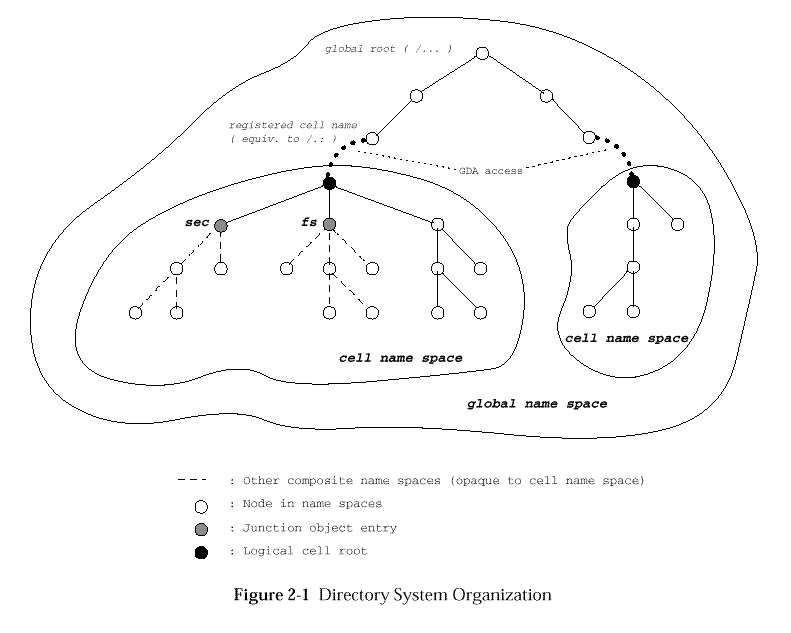
A Cell Directory Service (CDS) uses the location information in the
global name space to connect to the name spaces of foreign cells
(that is, cells that are not in a hierarchical relationship with
the requesting cell). The relationship of independent, non-hierarchical
cells registered in global name spaces is illustrated in

The GDA parses the global compound name according to the syntax rules for
DCE names. If the global compound name is identified as an X.500 name (that
is, if it contains at least one = (equal sign) character in its top-level
component), the GDA extracts the global compound name from the
fully-qualified global name, discards the global root component, and
issues a request to the corresponding X.500 service.
The progress record, which is returned by a successful1
GDA request, contains information about the directory service of the
targeted cell name space. It also contains the unresolved residual
The information returned by the GDA in the progress record is as follows:
-
-
11ed2286-49bb-11ca-8f29-08002b0dc46c
A child cell's fully-qualified global name consists of the global name
of the parent cell with the CDS name of the child cell appended to it.
The GDA parses the name according to the syntax rules for DCE names;
once it identifies the name of the parent cell it issues a request
to that cell's CDS. The progress record returned by a successful GDA
request corresponds to the progress record described in
The cell entries in the global name space uniquely identify the cell itself, as well as the location and type of CDS instances. If multiple instances of a CDS are available, the cell entry catalogues one record for each clearinghouse. The information that is required to catalogue a cell is defined as follows:
This is the unique identifier of the clearinghouse in the target cell; the binding to the cell name may not be sufficient to reach the cell, because the name of the clearinghouse may change.
Cell information is contained in two X.500 attribute types, CDS-Cell
and CDS-Replica. These attributes are either added to an existing
directory entry or created along with a new specific directory entry. The
syntax for both CDS-Cell and CDS-Replica attribute values is
an octet string (see
CDS-Cell contains the non-recurring cell information, as defined in
| Contents | Syntax | Presence |
|---|---|---|
| Target name space UUID | Printable string terminated by \0 | Mandatory |
| Cell root directory UUID | Printable string terminated by \0 | Only a \0 char if empty |
| Cell root directory name | Printable string terminated by \0 | Only a \0 char if empty |
CDS-Replica contains the set of recurring cell information, as
defined in
| Contents | Syntax | Presence |
|---|---|---|
| Clearinghouse type | 1 octet | GDA, Master or Read-only |
| Clearinghouse UUID | Printable string terminated by \0 | Mandatory |
| Clearinghouse name | Printable string terminated by \0 | Mandatory |
| Length of tower string | 4 octets numeric string | Value from 1-325 |
| Tower set | Octet string (with \0 separated set members) | Length from previous field |
The UUIDs are represented in string form, as specified in the DCE Remote Procedure Call specification.
The tower set contains network address information, consisting of a set of null-terminated RPC string binding representations of protocol towers (see the DCE Remote Procedure Call specification).
For both attribute types, the attribute values (represented by octet
strings) will vary in length. The current attribute value length is
automatically stored in the X.500 directory system. The maximum
attribute lengths must be defined in the X.500 schema (see
Cell information is contained in a pair of resource records (see RFC 1033 for recommendations on the contents of resource records). The resource records can be added to existing DNS nodes, or stored in newly created Internet domain names. The NIC Registrar is responsible for registering a domain name.
The resource records have the following type and contents:
The ASFDB or MX record indicates the host system on which the CDS server (replica, subtype 2) of the named cell exists. The DNS server also returns the associated Internet address of this host as additional data with the reply containing the AFSDB or MX record. The protocol class of this resource record is IN (Internet). TTL (time-to-live) is a value, expressed in seconds, after the elapse of which the data will no longer be considered valid in a DNS cache (the default value is set to the equivalent of one week).
The TXT record contains the set of recurring cell information, as well as the clearinghouse type and its address information. The fields in a TXT record are separated by white space, and their contents are case-insensitive.
The first TXT field indicates the version (1). The next field contains the UUID of the cell root directory. Following this is a three-field group defining the clearinghouse managed by the server:
The hostname of the clearinghouse is also included in the TXT record, to enable the corresponding AFSDB and TXT records to be matched.
Additional pairs of AFSDB and TXT records are used to define multiple clearinghouses.
Please note that the html version of this specification may contain formatting aberrations. The definitive version is available as an electronic publication on CD-ROM from The Open Group.
| Contents | Next section | Index |